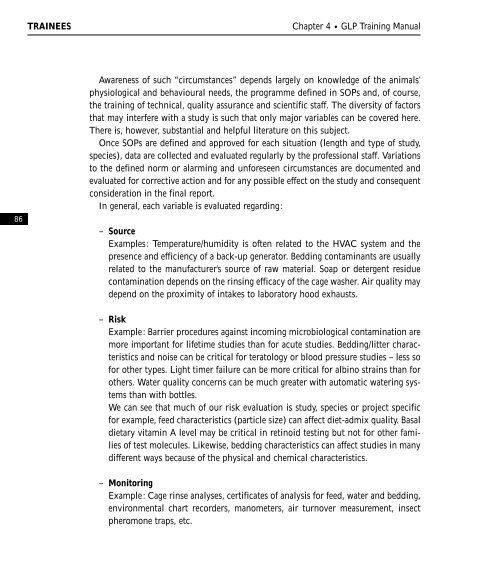TRAINEE - World Health Organization
TRAINEE - World Health Organization
TRAINEE - World Health Organization
You also want an ePaper? Increase the reach of your titles
YUMPU automatically turns print PDFs into web optimized ePapers that Google loves.
86<br />
<strong>TRAINEE</strong>S Chapter 4 • GLP Training Manual<br />
Awareness of such “circumstances” depends largely on knowledge of the animals’<br />
physiological and behavioural needs, the programme defined in SOPs and, of course,<br />
the training of technical, quality assurance and scientific staff. The diversity of factors<br />
that may interfere with a study is such that only major variables can be covered here.<br />
There is, however, substantial and helpful literature on this subject.<br />
Once SOPs are defined and approved for each situation (length and type of study,<br />
species), data are collected and evaluated regularly by the professional staff. Variations<br />
to the defined norm or alarming and unforeseen circumstances are documented and<br />
evaluated for corrective action and for any possible effect on the study and consequent<br />
consideration in the final report.<br />
In general, each variable is evaluated regarding:<br />
– Source<br />
Examples: Temperature/humidity is often related to the HVAC system and the<br />
presence and efficiency of a back-up generator. Bedding contaminants are usually<br />
related to the manufacturer’s source of raw material. Soap or detergent residue<br />
contamination depends on the rinsing efficacy of the cage washer. Air quality may<br />
depend on the proximity of intakes to laboratory hood exhausts.<br />
– Risk<br />
Example: Barrier procedures against incoming microbiological contamination are<br />
more important for lifetime studies than for acute studies. Bedding/litter characteristics<br />
and noise can be critical for teratology or blood pressure studies – less so<br />
for other types. Light timer failure can be more critical for albino strains than for<br />
others. Water quality concerns can be much greater with automatic watering systems<br />
than with bottles.<br />
We can see that much of our risk evaluation is study, species or project specific<br />
for example, feed characteristics (particle size) can affect diet-admix quality. Basal<br />
dietary vitamin A level may be critical in retinoid testing but not for other families<br />
of test molecules. Likewise, bedding characteristics can affect studies in many<br />
different ways because of the physical and chemical characteristics.<br />
– Monitoring<br />
Example: Cage rinse analyses, certificates of analysis for feed, water and bedding,<br />
environmental chart recorders, manometers, air turnover measurement, insect<br />
pheromone traps, etc.

















